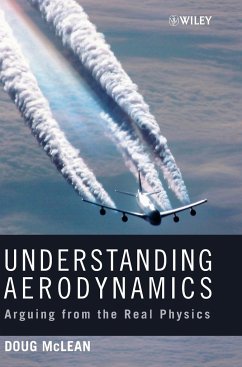Much-needed, fresh approach that brings a greater insight into the physical understanding of aerodynamics
Based on the author's decades of industrial experience with Boeing, this book helps students and practicing engineers to gain a greater physical understanding of aerodynamics. Relying on clear physical arguments and examples, Mcleanprovides a much-needed, fresh approach to this sometimes contentious subject without shying away from addressing "real" aerodynamic situations as opposed to the oversimplified ones frequently used for mathematical convenience. Motivated by the belief that engineering practice is enhanced in the long run by a robust understanding of the basics as well as real cause-and-effect relationships that lie behind the theory, he provides intuitive physical interpretations and explanations, debunking commonly-held misconceptions and misinterpretations, and building upon the contrasts provided by wrong explanations to strengthen understanding of the right ones.
Provides a refreshing view of aerodynamics that is based on the author's decades of industrial experience yet is always tied to basic fundamentals.
Provides intuitive physical interpretations and explanations, debunking commonly-held misconceptions and misinterpretations
Offers new insights to some familiar topics, for example, what the Biot-Savart law really means and why it causes so much confusion, what "Reynolds number" and "incompressible flow" really mean, and a real physical explanation for how an airfoil produces lift.
Addresses "real" aerodynamic situations as opposed to the oversimplified ones frequently used for mathematical convenience, and omits mathematical details whenever the physical understanding can be conveyed without them.
Hinweis: Dieser Artikel kann nur an eine deutsche Lieferadresse ausgeliefert werden.
Based on the author's decades of industrial experience with Boeing, this book helps students and practicing engineers to gain a greater physical understanding of aerodynamics. Relying on clear physical arguments and examples, Mcleanprovides a much-needed, fresh approach to this sometimes contentious subject without shying away from addressing "real" aerodynamic situations as opposed to the oversimplified ones frequently used for mathematical convenience. Motivated by the belief that engineering practice is enhanced in the long run by a robust understanding of the basics as well as real cause-and-effect relationships that lie behind the theory, he provides intuitive physical interpretations and explanations, debunking commonly-held misconceptions and misinterpretations, and building upon the contrasts provided by wrong explanations to strengthen understanding of the right ones.
Provides a refreshing view of aerodynamics that is based on the author's decades of industrial experience yet is always tied to basic fundamentals.
Provides intuitive physical interpretations and explanations, debunking commonly-held misconceptions and misinterpretations
Offers new insights to some familiar topics, for example, what the Biot-Savart law really means and why it causes so much confusion, what "Reynolds number" and "incompressible flow" really mean, and a real physical explanation for how an airfoil produces lift.
Addresses "real" aerodynamic situations as opposed to the oversimplified ones frequently used for mathematical convenience, and omits mathematical details whenever the physical understanding can be conveyed without them.
Hinweis: Dieser Artikel kann nur an eine deutsche Lieferadresse ausgeliefert werden.
"As someone who has been involved with aerodynamics for more years than I care to remember, I have rarely come across a book that is so readable and that provides so many (to me a least) genuinely new insights into the subject and its applications. This book should be high on the wish list of any practising aerodynamicist, whether in industry or academia." (Aeronautical Journal, 1 August 2013)
"This is a sophisticated book for people immersed in the study of fluid dynamics and aerodynamics; it will give them in-depth knowledge of both the physical phenomena and the mathematical equations that are used to describe and predict these phenomena. Summing Up: Recommended. Graduate students in aerospace engineering, researchers/faculty, and aircraft design professionals." (Choice, 1 July 2013)
"Based on the author's decades of industrial experience with Boeing, this book helps students and practicing engineers to gain a greater physical understanding of aerodynamics. Relying on clear physical arguments and examples, Mcleanprovides a much-needed, fresh approach to this sometimes contentious subject without shying away from addressing "real" aerodynamic situations as opposed to the oversimplified ones frequently used for mathematical convenience." (Expofairs.com, 11 March 2013)
"This is a sophisticated book for people immersed in the study of fluid dynamics and aerodynamics; it will give them in-depth knowledge of both the physical phenomena and the mathematical equations that are used to describe and predict these phenomena. Summing Up: Recommended. Graduate students in aerospace engineering, researchers/faculty, and aircraft design professionals." (Choice, 1 July 2013)
"Based on the author's decades of industrial experience with Boeing, this book helps students and practicing engineers to gain a greater physical understanding of aerodynamics. Relying on clear physical arguments and examples, Mcleanprovides a much-needed, fresh approach to this sometimes contentious subject without shying away from addressing "real" aerodynamic situations as opposed to the oversimplified ones frequently used for mathematical convenience." (Expofairs.com, 11 March 2013)

